Hold down the T key for 3 seconds to activate the audio accessibility mode, at which point you can click the K key to pause and resume audio. Useful for the Check Your Understanding and See Answers.
In the previous two sections of Lesson 2, the process of charging by friction and charging by induction were described and explained. In this section of Lesson 2, a third method of charging - charging by conduction - will be discussed. As was the case for charging by friction and charging by induction, the process of conduction will be described and explained using numerous examples of electrostatic demonstrations and lab experiments.
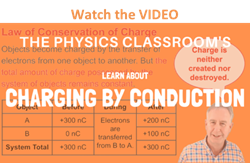 Charging by conduction involves the contact of a charged object to a neutral object. Suppose that a positively charged aluminum plate is touched to a neutral metal sphere. The neutral metal sphere becomes charged as the result of being contacted by the charged aluminum plate. Or suppose that a negatively charged metal sphere is touched to the top plate of a neutral needle electroscope. The neutral electroscope becomes charged as the result of being contacted by the metal sphere. And finally, suppose that an uncharged physics student stands on an insulating platform and touches a negatively charged Van de Graaff generator. The neutral physics student becomes charged as the result of contact with the Van de Graaff generator. Each of these examples involves contact between a charged object and a neutral object. In contrast to induction, where the charged object is brought near but never contacted to the object being charged, conduction charging involves making the physical connection of the charged object to the neutral object. Because charging by conduction involves contact, it is often called charging by contact.
Charging by conduction involves the contact of a charged object to a neutral object. Suppose that a positively charged aluminum plate is touched to a neutral metal sphere. The neutral metal sphere becomes charged as the result of being contacted by the charged aluminum plate. Or suppose that a negatively charged metal sphere is touched to the top plate of a neutral needle electroscope. The neutral electroscope becomes charged as the result of being contacted by the metal sphere. And finally, suppose that an uncharged physics student stands on an insulating platform and touches a negatively charged Van de Graaff generator. The neutral physics student becomes charged as the result of contact with the Van de Graaff generator. Each of these examples involves contact between a charged object and a neutral object. In contrast to induction, where the charged object is brought near but never contacted to the object being charged, conduction charging involves making the physical connection of the charged object to the neutral object. Because charging by conduction involves contact, it is often called charging by contact.
Charging by Conduction Using a Negatively Charged Object
To explain the process of charging by contact, we will first consider the case of using a negatively charged metal sphere to charge a neutral needle electroscope. Understanding the process demands that you understand that like charges repel and have an intense desire to reduce their repulsions by spreading about as far as possible. A negatively charged metal sphere has an excess of electrons; those electrons find each other repulsive and distance themselves from each other as far as possible. The perimeter the sphere is the extreme to which they can go. If there was ever a conducting pathway to a more spacious piece of real estate, one could be sure that the electrons would be on that pathway to the greener grass beyond. In human terms, electrons living in the same home despise each other and are always seeking a home of their own or at least a home with more rooms.
Given this understanding of electron-electron repulsions, it is not difficult to predict what excess electrons on the metal sphere would be inclined to do if the sphere were touched to the neutral electroscope. Once the contact of the sphere to the electroscope is made, a countless number of excess electrons from the sphere move onto the electroscope and spread about the sphere-electroscope system. In general, the object that offers the most space in which to "hang out" will be the object that houses the greatest number of excess electrons. When the process of charging by conduction is complete, the electroscope acquires an excess negative charge due to the movement of electrons onto it from the metal sphere. The metal sphere is still charged negatively, only it has less excess negative charge than it had prior to the conduction charging process.
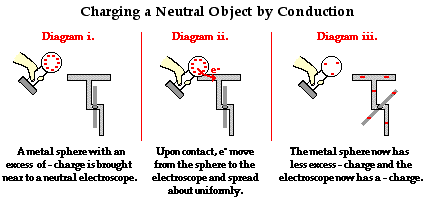
Charging by Conduction Using a Positively Charged Object
The previous example of charging by conduction involved touching a negatively charged object to a neutral object. Upon contact, electrons moved from the negatively charged object onto the neutral object. When finished, both objects were negatively charged. But what happens if a positively charged object is touched to a neutral object? To investigate this question, we consider the case of a positively charged aluminum plate being used to charge a neutral metal sphere by the process of conduction.
The diagram below depicts the use of a positively charged aluminum plate being touched to a neutral metal sphere. A positively charged aluminum plate has an excess of protons. When looked at from an electron perspective, a positively charged aluminum plate has a shortage of electrons. In human terms, we could say that each excess proton is rather discontented. It is not satisfied until it has found a negatively charged electron with which to co-habitate. However, since a proton is tightly bound in the nucleus of an atom, it is incapable of leaving an atom in search of that longed-for electron. It can however attract a mobile electron towards itself. And if a conducting pathway is made between a collection of electrons and an excess proton, one can be certain that there is likely an electron that would be willing to take the pathway. So when the positively charged aluminum plate is touched to the neutral metal sphere, countless electrons on the metal sphere migrate towards the aluminum plate. There is a mass migration of electrons until the positive charge on the aluminum plate-metal sphere system becomes redistributed. Having lost electrons to the positively charged aluminum plate, there is a shortage of electrons on the sphere and an overall positive charge. The aluminum plate is still charged positively; only it now has less excess positive charge than it had before the charging process began.
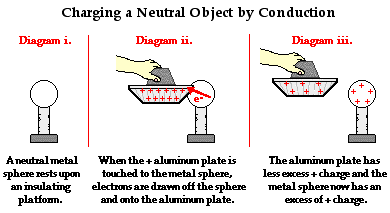
The above explanation might raise a rather difficult question: Why would an electron on the previously neutral metal sphere desire to move off the metal sphere in the first place? The metal sphere is neutral; every electron on it must be satisfied since there is a corresponding proton present. What would possibly induce an electron to go through the effort of migrating to a different territory in order to have what it already has?
The best means of answering this question requires an understanding of the concept of electric potential. But since that concept does not arise until the next unit of The Physics Classroom, a different approach to an answer will be taken. It ends up that electrons and protons are not as independent and individualized as we might think. From a human perspective, electrons and protons can't be thought of as independent citizens in a free enterprise system of government. Electrons and protons don't actually do what is best for themselves, but must be more social-minded. They must act like citizens of a state where the rule of law is to behave in a manner such that the overall repulsive affects within the society at large are reduced and the overall attractive affects are maximized. Electrons and protons will be motivated not by what is good for them, but rather by what is good for the country. And in this sense, a country's boundary extends to the perimeter of the conductor material that an excess electron is within. And in this case, an electron in the metal sphere is part of a country that extends beyond the sphere itself and includes the entire aluminum plate. So by moving from the metal sphere to the aluminum plate, an electron is able to reduce the total amount of repulsive affects within that country. It serves to spread the excess positive charge over a greater surface area, thus reducing the total amount of repulsive forces between excess protons.
Law of Conservation of Charge
In each of the other methods of charging discussed in Lesson 2 - charging by friction and charging by induction - the law of conservation of charge was illustrated. The law of conservation of charge states that charge is always conserved. When all objects involved are considered prior to and after a given process, we notice that the total amount of charge among the objects is the same before the process starts as it is after the process ends. The same conservation law is observed during the charging by conduction process. If a negatively charged metal sphere is used to charge a neutral electroscope, the overall charge before the process begins is the same as the overall charge when the process ends. So if before the charging process begins, the metal sphere has 1000 units of negative charge and the electroscope is neutral, the overall charge of the two objects in the system is -1000 units. Perhaps during the charging process, 600 units of negative charge moved from the metal sphere to the electroscope. When the process is complete, the electroscope would have 600 units of negative charge and the metal sphere would have 400 units of negative charge (the original 1000 units minus the 600 units it transferred to the electroscope). The overall charge of the two objects in the system is still -1000 units. The overall charge before the process began is the same as the overall charge when the process is completed. Charge is neither created nor destroyed; it is simply transferred from one object to another object in the form of electrons.
Conduction Charging Requires a Conductor
In all the above examples, the charging by conduction process involved the touching of two conductors. Does contact charging have to occur through the contact of two conductors? Can an insulator conduct a charge to another object upon touching? And can an insulator be charged by conduction? A complete discussion of these questions can get messy and quite often leads to a splitting of hairs over the definition of conduction and the distinction between conductors and 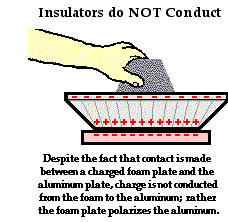 insulators. The belief is taken here that only a conductor can conduct charge to another conductor. The process of noticeably charging an object by contact involves the two contacting objects momentarily sharing the net excess charge. The excess charge is simply given a larger area over which to spread in order to reduce the total amount of repulsive forces between them. This process demands that the objects be conductors in order for electrons to move about and redistribute themselves. An insulator hinders such a movement of electrons between touching objects and about the surfaces of the objects. This is observed if an aluminum pie plate is placed upon a charged foam plate. When the neutral aluminum plate is placed upon the charged foam plate, the foam plate does not conduct its charge to the aluminum. Despite the fact that the two surfaces were in contact, charging by contact or conduction did not occur. (Or at least whatever charge transfer might have occurred was not noticeable by the customary means of using an electroscope, using a charge testing bulb or testing for its repulsion with a like-charged object.)
insulators. The belief is taken here that only a conductor can conduct charge to another conductor. The process of noticeably charging an object by contact involves the two contacting objects momentarily sharing the net excess charge. The excess charge is simply given a larger area over which to spread in order to reduce the total amount of repulsive forces between them. This process demands that the objects be conductors in order for electrons to move about and redistribute themselves. An insulator hinders such a movement of electrons between touching objects and about the surfaces of the objects. This is observed if an aluminum pie plate is placed upon a charged foam plate. When the neutral aluminum plate is placed upon the charged foam plate, the foam plate does not conduct its charge to the aluminum. Despite the fact that the two surfaces were in contact, charging by contact or conduction did not occur. (Or at least whatever charge transfer might have occurred was not noticeable by the customary means of using an electroscope, using a charge testing bulb or testing for its repulsion with a like-charged object.)
Many might quickly suggest that they have used a charged insulator to charge a neutral electroscope (or some other object) by contact. In fact, a negatively charged plastic golf tube can used to charge an electroscope. The plastic tube is touched to the top plate of the electroscope. On most occasions, the plastic tube is even rubbed or rolled across the plate of the electroscope? Wouldn't this be regarded as charging by conduction? No. Not really. In this case, it is more than 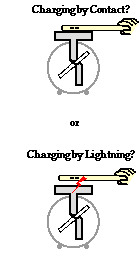 likely that the charging occurred by some process other than conduction. There was not a sharing of charge between the plastic tube and the metal parts of the electroscope. Of course, once some excess charge is acquired by the electroscope, that excess charge distributes itself about the surface of the electroscope. Yet the charge is not uniformly shared between the two objects. The protons and electrons within both the plastic golf tube and the electroscope are not acting together to share excess charge and reduce the total amount of repulsive forces.
likely that the charging occurred by some process other than conduction. There was not a sharing of charge between the plastic tube and the metal parts of the electroscope. Of course, once some excess charge is acquired by the electroscope, that excess charge distributes itself about the surface of the electroscope. Yet the charge is not uniformly shared between the two objects. The protons and electrons within both the plastic golf tube and the electroscope are not acting together to share excess charge and reduce the total amount of repulsive forces.
The charging of an electroscope by contact with a negatively charged golf tube (or any charged insulating object) would best be described as charging by lightning. Rather than being a process in which the two objects act together to share the excess charge, the process could best be described as the successful effort of electrons to burst through the space (air) between objects. The presence of a negatively charged plastic tube is capable of ionizing the air surrounding the tube and allowing excess electrons on the plastic tube to be conducted through the air to the electroscope. This transfer of charge can happen with or without touching. In fact, on a dry winter day the process of charging the metal electroscope with the charged insulator often occurs while the insulator is some distance away. The dry air is more easily ionized and a greater quantity of electrons is capable of bursting through the space between the two objects. On such occasions, a crackling sound is often heard and a flash of light is seen if the room is darkened. This phenomenon, occurring from several centimeters away, certainly does not fit the description of contact charging.
A charged insulating object is certainly capable of transferring its charge to another object. The result of the charge transfer will be the same as the result of charging by conduction. Both objects will have the same type of charge and the flow of electrons is in the same direction. However, the process and the underlying explanations are considerably different. In the case of charging an object with a charged insulator, the contact is not essential. Contacting the object simply reduces the spatial separation between touching atoms and allows charge to arc and spark its way between objects. Rubbing or rolling the insulating object across the conductor's surface facilitates the charging process by bringing a greater number of atoms on the insulator in close proximity to the conductor that is receiving the charge. The two materials do not make any effort to share charge nor to act as a single object (with a uniform electric potential) in an effort to reduce repulsive affects.
Is this distinction between charging by conduction and charging by lightning a splitting of hairs? Perhaps. For certain, each process involves a transfer of charge from one object to another object, yielding the same result - two like-charged object. Yet, distinguishing between the two forms of charging is more consistent with the customary view that insulators are not conductors of charge. It also serves to explain why some insulators clearly do not always transfer their charge upon contact. This phenomenon of charging by lightning will be revisited in Lesson 4 during a discussion of electric fields and lightning discharges.
We Would Like to Suggest ...

Sometimes it isn't enough to just read about it. You have to interact with it! And that's exactly what you do when you use one of The Physics Classroom's Interactives. We would like to suggest that you combine the reading of this page with the use of our
Charging Interactive. You can find it in the Physics Interactives section of our website. The
Charging Interactive is an electrostatics "playground" that allows a learner to investigate a variety of concepts related to charge, charge interactions, charging processes, and grounding. Once you get the hang of the concepts, put your game-face on tap the Play button.
Check Your Understanding
Use your understanding of charge to answer the following questions. When finished, click the button to view the answers.
1. A neutral metal sphere is touched by a negatively charged metal rod. As a result, the sphere will be ____ and the metal rod will be ____. Select the two answers in their respective order.
a. positively charged
b. negatively charged
c. neutral
d. much more massive
e. ... not enough information to tell
2. A neutral metal sphere is touched by a negatively charged metal rod. During the process, electrons are transferred from the _____ to the _____ and the sphere acquires a _____ charge.
a. neutral sphere, charged rod, negative
b. neutral sphere, charged rod, positive
c. charged rod, neutral sphere, negative
d. charged rod, neutral sphere, positive
e. ... nonsense! None of these describe what occurs.
3. A neutral metal sphere is touched by a positively charged metal rod. During the process, protons are transferred from the _____ to the _____ and the sphere acquires a _____ charge.
a. charged rod, neutral sphere, negative
b. charged rod, neutral sphere, positive
c. neutral sphere, charged rod, negative
d. neutral sphere, charged rod, positive
e. ... nonsense! None of these describe what occurs.
4. A metal sphere is electrically neutral. It is touched by a positively charged metal rod. As a result, the metal sphere becomes charged positively. Which of the following occur during the process? List all that apply.
a. The metal sphere gains some protons.,/p.
b. Electrons are transferred from the sphere to the rod.
c. The metal sphere loses electrons.
d. The overall charge of the system is conserved.
e. Protons are transferred from the rod to the sphere.
f. Positive electrons are moved between the two objects.